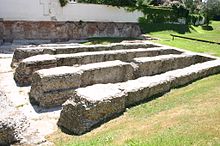Early Christian churches in Milan
45°28′N 09°11′E / 45.467°N 9.183°E
You can help expand this article with text translated from the corresponding article in Italian. (April 2011) Click [show] for important translation instructions.
|

Early Christian churches in Milan are the first churches built immediately after the Edict of Milan (Edictum Mediolanense) in February 313, issued by Constantine the Great and Licinius, which granted tolerance and religious liberty to Christianity within the Roman Empire.
Historical and artistic context
Ever since the fall of the
During the
Wherefore, for this our indulgence, they ought to pray to their God for our safety, for that of the republic, and for their own, that the commonwealth may continue uninjured on every side, and that they may be able to live securely in their homes.
Edict of Toleration by Galerius (311 AD)[2]
the same shall be restored to the Christians without payment or any claim of recompense and without any kind of fraud or deception
Edict of Milan (313 AD)[2]

An edict of toleration was issued by the emperor
It was from Mediolanum that the Emperor Constantine issued the Edict of Milan in 313 AD, granting tolerance to all religions within the Empire, thus paving the way for Christianity to become the dominant religion of the Empire. Constantine was in Mediolanum to celebrate the wedding of his sister to the Eastern Emperor, Licinius. The agreement between Constantine and Licinius directed the provincial magistrates to execute its orders at once and with all energy, so that public order may be restored and the continuance of the Divine favour may "preserve and prosper our successes together with the good of the state." It marked the beginning of profound and radical transformations; the encouragement of Christian worship led to the methodical destruction of Christian monuments invisible to the authorities.
Stones taken from the
Constantinian churches

The early Christian basilicas in Mediolanum can be divided into several categories, corresponding to their periods.
The first basilicas we know are divided into two separate churches, one for the
This section needs expansion. You can help by adding to it . (June 2013) |
A later stage corresponds to that of the great cathedrals of the late Roman Empire. They are formed by a polygonal shape and cross-stitch. These churches were the models adopted for some of the largest most famous basilicas of the late Roman Empire, such as those in Constantinople.
The religious center of the city, now Piazza del Duomo, included two cathedrals: the basilica vetus or basilica minor, used during the winter season, and basilica nova or basilica major, used during the summer. These churches are only partly known because the Milan Cathedral has been built over there.[6]
- Basilica vetus (313)
- Basilica di Santa Tecla/ Basilica maior
- Basilica of San Lorenzo (c. 370)[7]
When
Ambrosian churches
This section needs expansion. You can help by adding to it. (June 2013) |
With the Roman governor and bishop Ambrose began a program to build basilicas dedicated to various categories: a basilica for the
The first Ambrosian church in Milan was founded by Saint Ambrose in the 4th century. This church, known as the Basilica Ambrosiana, became the center of the Ambrosian Rite, which is still used in some parts of the world today. Other Ambrosian churches were later built in Milan and other cities in Italy, but the Basilica Ambrosiana remains the most important and influential of these.[9]
- Basilica martyrium / Basilica of Sant'Ambrogio (379–386)
- San Nazaro in Brolo (382–397)
- Basilica of San Simpliciano
- Basilica Salvatoris/Basilica of San Dionigi
Other churches
This section needs expansion. You can help by adding to it. (June 2013) |
Other early Christian churches in Milan that preserve some of their Palaeo-Christian appearance are:
- San Vittore al Corpo (originally the imperial mausoleum of Maximian(r. 285–305, 306–310))
- Basilica di San Calimero (5th-century, rebuilt 19th century)
- San Vincenzo in Prato (8th-century)
References
- ^ Frend, W. H. C. (1965). The Early Church. SPCK. p. 135.
- ^ a b Halsall, Paul (January 1996). "Galerius and Constantine: Edicts of Toleration 311/313". Fordham University.
- Lactantius (1844). "34, 35, 48". In Fritzsche, O. F. (ed.). Opera: De Mortibus Persecutorum. Vol. II. Leipzig. pp. 273, 288.
(Bibl. Patt. Ecc. Lat. XI)
- University of Pennsylvania. Department of History (1907) [1897]. Translations and Reprints from the Original Sources of European History. Vol. 4. Philadelphia: University of Pennsylvania Press. pp. 28–30.
- Lactantius (1844). "34, 35, 48". In Fritzsche, O. F. (ed.). Opera: De Mortibus Persecutorum. Vol. II. Leipzig. pp. 273, 288.
- ^ Stevenson, J. (1965). A New Eusebius. SPCK. p. 296.
- ^ Eusebius, Ecclesiastical History 5.15-17
- ^ Benario, Herbert W. (February 1981). "Amphitheatres of the Roman World". The Classical Journal. 76 (3): 255–258.
- ^ Lusardi Siena, Silvia (2012). Biscottini, Paolo; Sena Chiesa, Gemma (eds.). Quale cattedrale nel 313 d.C.? Nota per una messa a punto del problema del primitivo gruppo episcopale [Which Cathedral in 313 AD? Note for a Tune-up of the Problem of the Primitive Episcopal Group] (in Italian). Milan: Mondadori Electa/Mostra di Palazzo Reale (25 October 2012 – 17 March 2013). pp. 29–33.
- ^ Sutton. Western Architecture. p. 24.
- ^ ISBN 978-0-521-19605-5.
- ISSN 0004-3443.
Bibliography
- De Vecchi, Pierluigi; Cerchiari, Elda (1999). I tempi dell'arte [The Times of the Art] (in Italian). Vol. 1. Milan: Bompiani.
